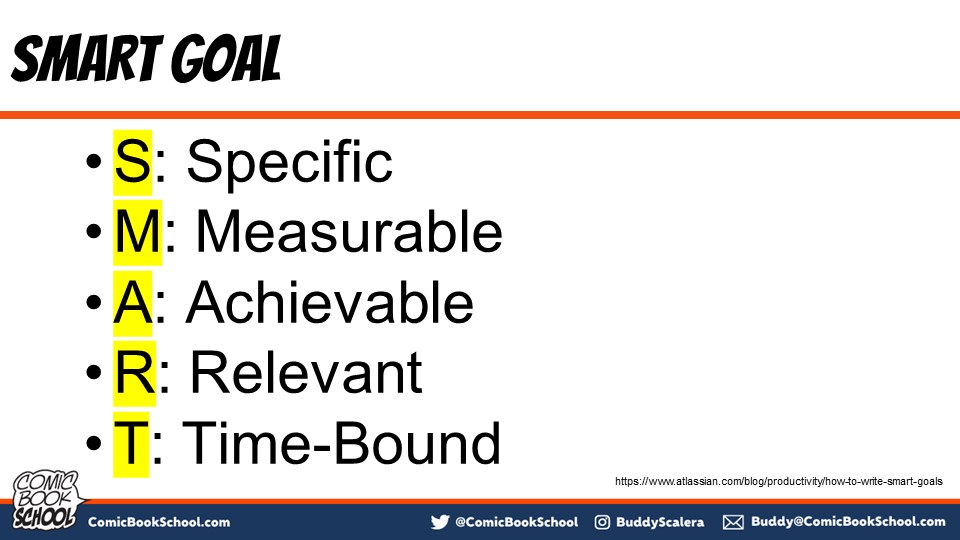Planning your goals for the year can be challenging and intimidating. It may seem like everyone knows how to plan smart goals. It’s a good time to learn how to plan your goals using the SMART method.
This year at Comic Book School we will use the SMART method, which some of you may already know from your job. This is how many companies plan annual goals for employees. You can use it for your comic book planning.
What Is a SMART Goal?
SMART is an acronym that stands for:
- S: Specific
- M: Measurable
- A: Achievable
- R: Relevant
- T: Time Bound
SMART can be applied to a full-year plan or an individual deliverable, including a comic book project. Let’s look at it through the lens of making comics. I suggest you write these down in one of the notebooks you have designated for your comic book projects.

Specific
What kind of comic book do you want to make? Is it an 8-page backup, a single 20-page comic, or a complete mini series.
Tip: Think carefully about what kind of comic you can create to be ready for a specific purpose. If this is for your portfolio, you may want to focus on a single-issue story. The 20-page format allows you to show a complete story from start to end. If this is your first project, an 8-page story may be the best starting point.
Measurable
What defines complete to you? You can “measure” your progress by completing all of the steps. A comic will need to be written, drawn, inked, colored, letter, and then compiled. This is up to you, but you need to create something that is within your reach to complete. You may be able to do it all yourself or you may need to organize a team.
Consider all of the steps. The process is measurably complete when you say it is complete. Write down these goals, so you know when you’ve met your goals.
Achievable
You will need to be very honest with yourself and your current capabilities. You can only achieve steps and tasks that are in your control.
If you decide that you will hire someone (e.g., a letterer), you need to be ready to pay the creator somehow. This is achievable.
You cannot include goals beyond your control. For example, you may not be able to achieve a goal of getting someone to publish this for you. You can create your comic book, but you cannot set a goal to have Image Comics or Dark Horse Comics publish this comic. Focus on what you can achieve without an external person deciding something in your favor.
You can set a goal for being published, but you should set SMART goals for discreet, specific tasks at this time. We can talk about long-term career goals later.
Relevant
You should decide what you really want to achieve. If you want to make comics, then this SMART goal should be relevant to your goal. This SMART goal should be a building block to a long term goal.
Tip: I always share my goals with my circle of trusted peers. There are times when people will tell me that this particular goal will not help me reach my longer goal. You should create a circle of people you trust. Share your idea with them and ask for honest feedback.
Time Bound
Think about the amount of time it will take each step. If you are working with other people, you will need to make sure you fit into their schedule. People often fail to plan enough time for the process. Talk to your collaborators. Let them know when you want the final product and work backward.
It’s a good idea to maintain a calendar that helps you with target dates.
Tip: You can use industry standard timelines as a starting point, but beware. These dates are usually established with freelancers who do this kind of work full time. Yes, many working pros can complete a page of art per day, but your artist may not be able to meet that timeline. An artist who works a day job may be able to complete a page a week.
Imagine that you want to create a 20-page comic. That could easily be a 20-week process with someone who is working on this part time.
CBS|Live Show
We discuss this in detail in this episode of CBS|Live. You will see Mike Fasolo and me discuss the SMART method and how you can use it to make comics. Be sure to like the video and subscribe for useful information about the craft and business of making comics.
Further Reading
You can and should do a bit of reading to learn more about the SMART process. Here are some links to guide your thinking.
How to Write SMARTGoals (Atlassian)
A Brief History of SMART Goals (ProjectSmart)
Facing Pages & Page Numbering for Writing Comic Books (Comic Book School)
What Comic Creators Can Learn from The Breakfast Club (1885) – Story Analysis (Comic Book School)
There! Don’t you already feel SMART-er? Yes, you do!

